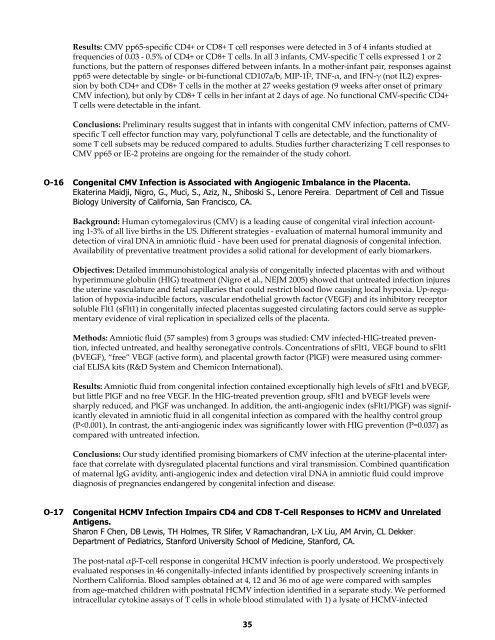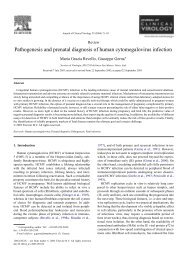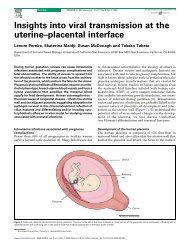Congenital Cytomegalovirus Conference - Congenital CMV ...
Congenital Cytomegalovirus Conference - Congenital CMV ...
Congenital Cytomegalovirus Conference - Congenital CMV ...
Create successful ePaper yourself
Turn your PDF publications into a flip-book with our unique Google optimized e-Paper software.
Results: <strong>CMV</strong> pp65-specific CD4+ or CD8+ T cell responses were detected in 3 of 4 infants studied at<br />
frequencies of 0.03 - 0.5% of CD4+ or CD8+ T cells. In all 3 infants, <strong>CMV</strong>-specific T cells expressed 1 or 2<br />
functions, but the pattern of responses differed between infants. In a mother-infant pair, responses against<br />
pp65 were detectable by single- or bi-functional CD107a/b, MIP-1β, TNF-α, and IFN-γ (not IL2) expression<br />
by both CD4+ and CD8+ T cells in the mother at 27 weeks gestation (9 weeks after onset of primary<br />
<strong>CMV</strong> infection), but only by CD8+ T cells in her infant at 2 days of age. No functional <strong>CMV</strong>-specific CD4+<br />
T cells were detectable in the infant.<br />
Conclusions: Preliminary results suggest that in infants with congenital <strong>CMV</strong> infection, patterns of <strong>CMV</strong>specific<br />
T cell effector function may vary, polyfunctional T cells are detectable, and the functionality of<br />
some T cell subsets may be reduced compared to adults. Studies further characterizing T cell responses to<br />
<strong>CMV</strong> pp65 or IE-2 proteins are ongoing for the remainder of the study cohort.<br />
O-16 <strong>Congenital</strong> <strong>CMV</strong> Infection is Associated with Angiogenic Imbalance in the Placenta.<br />
Ekaterina Maidji, Nigro, G., Muci, S., Aziz, N., Shiboski S., Lenore Pereira. Department of Cell and Tissue<br />
Biology University of California, San Francisco, CA.<br />
Background: Human cytomegalovirus (<strong>CMV</strong>) is a leading cause of congenital viral infection accounting<br />
1-3% of all live births in the US. Different strategies - evaluation of maternal humoral immunity and<br />
detection of viral DNA in amniotic fluid - have been used for prenatal diagnosis of congenital infection.<br />
Availability of preventative treatment provides a solid rational for development of early biomarkers.<br />
Objectives: Detailed immmunohistological analysis of congenitally infected placentas with and without<br />
hyperimmune globulin (HIG) treatment (Nigro et al., NEJM 2005) showed that untreated infection injures<br />
the uterine vasculature and fetal capillaries that could restrict blood flow causing local hypoxia. Up-regulation<br />
of hypoxia-inducible factors, vascular endothelial growth factor (VEGF) and its inhibitory receptor<br />
soluble Flt1 (sFlt1) in congenitally infected placentas suggested circulating factors could serve as supplementary<br />
evidence of viral replication in specialized cells of the placenta.<br />
Methods: Amniotic fluid (57 samples) from 3 groups was studied: <strong>CMV</strong> infected-HIG-treated prevention,<br />
infected untreated, and healthy seronegative controls. Concentrations of sFlt1, VEGF bound to sFlt1<br />
(bVEGF), “free” VEGF (active form), and placental growth factor (PlGF) were measured using commercial<br />
ELISA kits (R&D System and Chemicon International).<br />
Results: Amniotic fluid from congenital infection contained exceptionally high levels of sFlt1 and bVEGF,<br />
but little PlGF and no free VEGF. In the HIG-treated prevention group, sFlt1 and bVEGF levels were<br />
sharply reduced, and PlGF was unchanged. In addition, the anti-angiogenic index (sFlt1/PlGF) was significantly<br />
elevated in amniotic fluid in all congenital infection as compared with the healthy control group<br />
(P





